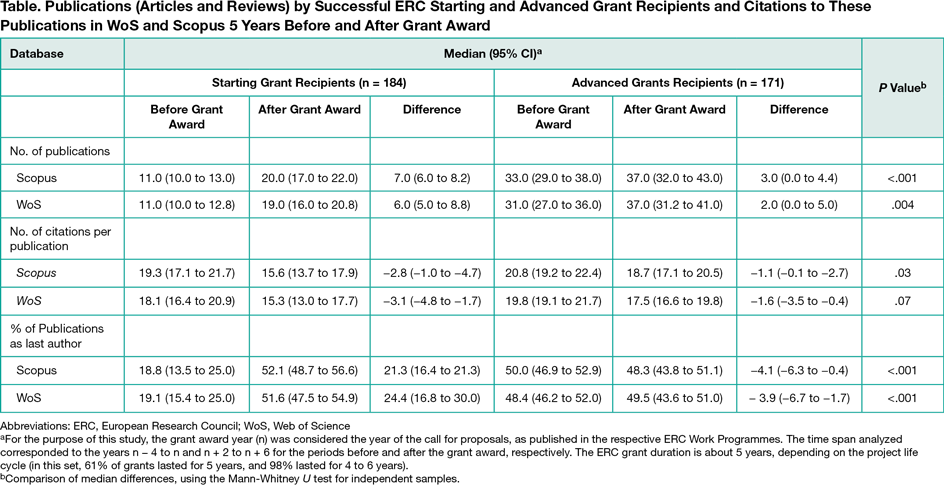Abstract
Association of Publication Rate With the Award of Starting and Advanced Grants
David Pina,1 Lana Barać,2,3 Ivan Buljan,3 Ana Marušić3
Objective
To analyze the association of European Research Council (ERC) funding with the bibliometric output of successful grantees.
Design
We analyzed publicly available data on the cohort of 2007-2009 ERC grantees in the Life Sciences domain (N = 355) for the Starting Grant (StG; n = 184) and the Advanced Grant (AdG; n = 171). The numbers of articles/reviews and citations in Scopus and Web of Science (WoS) were extracted for 5-year periods before and after the grant award. The Mann-Whitney U test was used for comparisons.
Results
There were more male grantees (291 of 355 [82%]), both for the StG (144 of 184 [78%]) and the AdG (147 of 171 [86%]) (P = .93). The StG recipients published 2542 articles indexed in Scopus before the grant award and 4086 articles indexed in Scopus after the grant award, and they published 2476 articles indexed in WoS before the grant award and 3901 articles indexed in WoS after the grant award. The AdG recipients published 7448 articles indexed in Scopus before the grant award and 8624 indexed in Scopus after the grant award, and they published 7197 articles indexed in WoS before the grant award and 8382 articles indexed in WoS after the grant award. The StG recipients had a significantly greater increase in the number of publications after the award (Table). Most of the publications by both grantee groups were in Scopus first-quartile journals (median percentage for StG recipients, 93% [95% CI, 92%-94%]; median percentage for AdG recipients, 92% [95% CI, 81%-94%]). The mean numbers of citations per publication were similar for both the StG and AdG recipients and did not change over time. The percentage of publications with the grantee as last author significantly increased for StG recipients and decreased for AdG recipients after the grant award. There were no gender differences for StG recipients; female AdG recipients had significantly fewer publications indexed in Scopus than did male AdG recipients after the grant award (median difference, −3.0 [95% CI, −6.5 to 3.3] vs 4.0 [95% CI, 2.0-7.0]; P = .006) but more last authorships indexed in Scopus (median difference, 3.6 [95% CI, −1.8 to 8.2] vs −0.1 [95% CI, −0.1 to 1.0]; P = .006). Female but not male StG recipients outperformed AdG recipients in publication output and last authorships (data not shown). There was no difference between StG and AdG recipients in the mean publication cost from the grant (total grant funding divided by number of publications after grant award: €63.000 [95% CI, €52,800-€70,300] vs €56,900 [95% CI, €50,000-€62,500]; P = .08).
Conclusions
European Research Council funding to StG recipients was associated with increased numbers of publications and last authorships on these publications. An important limitation of our study was the lack of a control group of unsuccessful ERC grant applicants, but the data were not publicly available. It is not clear how to best measure the productivity of AdG recipients because their publication and citation output did not change with ERC funding.
1Research Executive Agency, European Commission, Brussels, Belgium; 2Research Office, University of Split School of Medicine, Split, Croatia; 3Department of Research in Biomedicine and Health, University of Split School of Medicine, Split, Croatia, ana.marusic@mefst.hr
Conflict of Interest Disclosures:
Dr Marušić is member of the Peer Review Congress Advisory Board but was not involved in the review or decision for this abstract. No other disclosures reported.

